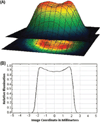Long-term monitoring of live cell proliferation in presence of PVP-Hypericin: a new strategy using ms pulses of LED and the fluorescent dye CFSE
- PMID: 21974829
- PMCID: PMC3232286
- DOI: 10.1111/j.1365-2818.2011.03555.x
Long-term monitoring of live cell proliferation in presence of PVP-Hypericin: a new strategy using ms pulses of LED and the fluorescent dye CFSE
Abstract
During fluorescent live cell imaging it is critical to keep excitation light dose as low as possible, especially in the presence of photosensitizer drugs, which generate free radicals upon photobleaching. During fluorescent imaging, stress by excitation and free radicals induces serious cell damages that may arrest the cell cycle. This limits the usefulness of the technique for drug discovery, when prolonged live cell imaging is necessary. This paper presents a strategy to provide gentle experimental conditions for dynamic monitoring of the proliferation of human lung epithelial carcinoma cells (A549) in the presence of the photosensitizer Polyvinylpyrrolidone-Hypericin. The distinctive strategy of this paper is based on the stringent environmental control and optimizing the excitation light dose by (i) using a low-power pulsed blue light-emitting diode with short pulse duration of 1.29 ms and (ii) adding a nontoxic fluorescent dye called carboxyfluorescein-diacetate-succinimidyl-ester (CFSE) to improve the fluorescence signals. To demonstrate the usefulness of the strategy, fluorescence signals and proliferation of dual-marked cells, during 5-h fluorescence imaging under pulsed excitation, were compared with those kept under continuous excitation and nonmarked reference cells. The results demonstrated 3% cell division and 2% apoptosis due to pulsed excitation compared to no division and 85% apoptosis under the continuous irradiation. Therefore, our strategy allows live cell imaging to be performed over longer time scales than with conventional continuous excitation.
© 2011 The Authors Journal of Microscopy © 2011 Royal Microscopical Society.
Figures








Similar articles
-
Modifying excitation light dose of novel photosensitizer PVP-Hypericin for photodynamic diagnosis and therapy.J Photochem Photobiol B. 2013 Mar 5;120:120-9. doi: 10.1016/j.jphotobiol.2012.12.013. Epub 2013 Jan 10. J Photochem Photobiol B. 2013. PMID: 23375215
-
Optimizing the antitumor selectivity of PVP-Hypericin re A549 cancer cells and HLF normal cells through pulsed blue light.Photodiagnosis Photodyn Ther. 2013 Dec;10(4):591-9. doi: 10.1016/j.pdpdt.2013.06.005. Epub 2013 Aug 5. Photodiagnosis Photodyn Ther. 2013. PMID: 24284116
-
Stroboscopic illumination using light-emitting diodes reduces phototoxicity in fluorescence cell imaging.Biotechniques. 2006 Aug;41(2):191-7. doi: 10.2144/000112220. Biotechniques. 2006. PMID: 16925021
-
Flow cytometric analysis of cell division by dilution of CFSE and related dyes.Curr Protoc Cytom. 2013;Chapter 9:9.11.1-9.11.12. doi: 10.1002/0471142956.cy0911s64. Curr Protoc Cytom. 2013. PMID: 23546777 Review.
-
Molecular photobleaching kinetics of Rhodamine 6G by one- and two-photon induced confocal fluorescence microscopy.Chemphyschem. 2005 May;6(5):791-804. doi: 10.1002/cphc.200400509. Chemphyschem. 2005. PMID: 15884061 Review.
Cited by
-
Investigating the impact of oxygen concentration and blood flow variation on photodynamic therapy.Proc SPIE Int Soc Opt Eng. 2016 Feb 13;9694:96940L. doi: 10.1117/12.2211120. Epub 2016 Mar 1. Proc SPIE Int Soc Opt Eng. 2016. PMID: 27453622 Free PMC article.
-
PDT Dose Dosimeter for Pleural Photodynamic Therapy.Proc SPIE Int Soc Opt Eng. 2016 Mar 17;9694:96940Y. doi: 10.1117/12.2213401. Proc SPIE Int Soc Opt Eng. 2016. PMID: 27053825 Free PMC article.
-
Excitation Light Dose Engineering to Reduce Photo-bleaching and Photo-toxicity.Sci Rep. 2016 Aug 3;6:30892. doi: 10.1038/srep30892. Sci Rep. 2016. PMID: 27485088 Free PMC article.
-
Live-cell imaging.Cell Adh Migr. 2014;8(5):452-9. doi: 10.4161/cam.28348. Epub 2014 Oct 31. Cell Adh Migr. 2014. PMID: 25482523 Free PMC article.
-
A novel tumor-immune microenvironment (TIME)-on-Chip mimics three dimensional neutrophil-tumor dynamics and neutrophil extracellular traps (NETs)-mediated collective tumor invasion.Biofabrication. 2021 Apr 8;13(3):10.1088/1758-5090/abe1cf. doi: 10.1088/1758-5090/abe1cf. Biofabrication. 2021. PMID: 33524968 Free PMC article.
References
-
- Borlinghaus RT. MRT letter: high speed scanning has the potential to increase fluorescence yield and to reduce photobleaching. Microsc. Res. Tech. 2006;69:689–692. - PubMed
-
- Bovik AC. Handbook of Image and Video Processing. 2nd ed. New York: Elsevier Academic Press; 2005.
-
- Connally RE, Piper JA. Time-gated luminescence microscopy. Ann N.Y. Acad Sci. 2008;1130:106–116. - PubMed
-
- Frigault MM, Lacoste J, Swift JL, Brown CM. Live-cell microscopy: tips and tools. J. Cell Sci. 2009;122:753–767. - PubMed
-
- Goldman RD, Spector DL. Live Cell Imaging, a Laboratory Manual. New York: Cold Spring Harbor Laboratory; 2005. pp. 337–338.
Publication types
MeSH terms
Substances
Grants and funding
LinkOut - more resources
Full Text Sources

